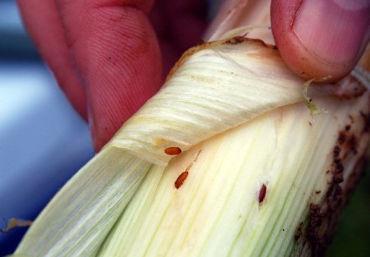By Shelby Fleischer,Timothy Elkner.et.al
They also utilize weedy hosts (wild garlic, garlic chives) and ornamental alliums. A key to management is to target the adults and young larval stages with insecticides or row covers. The timing for that is now.
Adults (Figures 1 and 2) are active for a short (3 to 7 week) time frame in the spring and the fall. The adult is small (3-4 mm, larger than a fruit fly but much smaller than a housefly) and have a yellow patch on the face. The fall flight activity started within the last week. We found adults and feeding/egg-laying punctures at multiple sites in Lancaster and Centre counties on September 19 and 20 of last week.
These adults are emerging from pupae that have been aestivating (going through a summer dormancy) for the last approximately four months. They will emerge, find allium hosts, mate, and lay eggs into leaf tissue. That egg-laying results in a diagnostic linear series of circular white dots (Figure 1): scout carefully for those dots. Those eggs will develop into larvae, which will mine inside of leaf tissue as they feed and develop into pupae. Those pupae will overwinter.
Figure 1. Female puncturing leaf with an ovipositor. Note linear puncture marks, a sign of adult activity.
Figure 2. Adult ALM: Note the yellow head patch.
Leeks and scallions tend to be the hosts where we have seen the highest rates of infestation (Figure 3). Row covers during the flight period should prevent damage. Weekly foliar insecticides applied during the flight period that have been most effective in leeks include Exirel, Radiant, Scorpion, Warrior, Entrust, and Assail. Entrust is OCIA-labelled. Several of these are systemic (Exirel, Scorpion) or have translaminar activity (Entrust), which may help control young larvae that are in the leaf tissue. Also, whenever applying insecticides to allium crops, it helps to include a surfactant, which may help deliver to insecticide to the target. We’ve been using LI-700 for conventional plots, and MPede for the organic plots, as surfactants. Foliar applications in leeks have worked better than application through drip irrigation. Other OCIA-labelled options (AzaDirect and Pyganic) have sometimes performed better than untreated controls, but not consistently, and surprisingly in some studies, the damage was greater in Pyganic-treated plots.

Figure 3. Pupae in the base of allium plants. Photo: L. Donoval
It’s difficult to determine when flight has ended. Scouting early in the morning, when temperatures are cool, is the best timing for seeing the adult flies. We’ve also marked leaves that have oviposition punctures with a Sharpie, and when we no longer see new oviposition marks, we conclude flight is ending. We will be updating this post to let you know when we no longer see new oviposition marks in plots in Landisville.